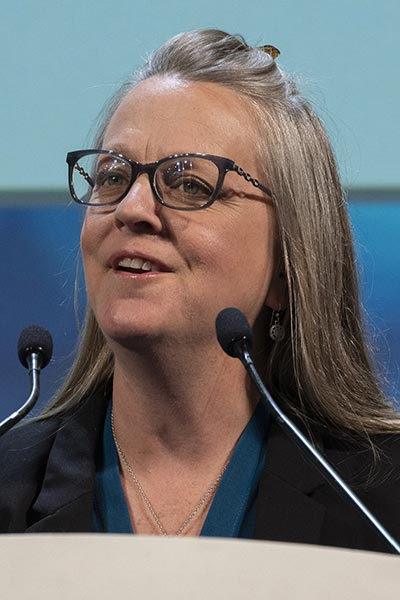Next-generation cancer therapies will reshape cancer treatment in the coming years
//
Estimated Read Time:
The next generation of cancer therapies — engineered proteins, microRNAs, nanocarriers, and novel antibody-drug conjugates — have the potential to reshape cancer treatment in the coming years.
Five leading researchers discussed their recent discoveries and explored future directions during the plenary session New Concepts in Drug Discovery and Engineering on Wednesday, April 19. The session can be viewed on the virtual meeting platform by registered Annual Meeting participants through July 19, 2023.
Engineered proteins

Monoclonal antibodies continue to transform cancer treatment, but antibodies typically bind to their targets with picomolar to nanomolar affinity. It takes femtomolar (fM) affinity to effectively block strong ligand-receptor interactions.
The AXL receptor tyrosine kinase has long been recognized as a promising therapeutic target for inhibiting metastasis, proliferation, resistance, and other tumor behaviors. AXL binds to growth arrest-specific protein 6 (Gas6) with a high affinity, making it difficult to target with conventional antibody approaches. A second-generation engineered AXL protein decoy has a 90 fM affinity to the Gas6 ligand, tighter than virtually all binding interactions found in nature.
“In combination with doxorubicin, we get a greater than 99 percent reduction in metastatic spread,” reported Jennifer R. Cochran, PhD, the Addie and Al Macovski Professor of Bioengineering and Professor of Chemical Engineering at the Stanford University Schools of Engineering and Medicine, of her team’s ovarian cancer cell xenograft model. “This molecule is currently in phase III trials for platinum-resistant ovarian cancer and in phase I/II trials for clear cell renal cell carcinoma and pancreatic adenocarcinoma.”
Looking further ahead, peptide-drug conjugates (PDCs) are a viable alternative to antibody-drug conjugates (ADCs), Cochran said. PDCs offer faster clearance of toxic payloads and enhanced tumor penetration due to their small size.
In a head-to-head comparison of an integrin-targeting PDC, ADC, and Fc fusion protein, the PDC was the most successful at blocking the growth of tumor cell xenografts in mice.
“If you have something that’s super small with very high binding affinity, you can be in that sweet spot of good extravasation and really robust tumor uptake,” Cochran added.
MiRNA delivery vehicles

MicroRNAs (miRNAs) are another emerging alternative to antibody therapeutics, but RNA-based drugs targeting cancer have been slow to develop.
“We’ve got to get the miRNA to the cell of interest, into the cell, into the right intracellular compartment, and stabilize the RNA,” said Andrea Kasinski, PhD, the William and Patty Miller Associate Professor of Biological Science and Program Leader at Purdue Institute for Cancer Research.
While past methods to encapsulate miRNAs to help them overcome these hurdles have been fairly toxic, Kasinski suggested removing the protective machinery and instead targeting the miRNA to the tumor cells using a ligand. Such ligands can include glycoproteins, synthetic oligodeoxynucleotides, aptamers, and small molecules, Kasinki explained.
Ligand-mediated, vehicle-free delivery targeting a synthetic dye to folate receptors has already been approved for tumor imaging. Folate receptors are overexpressed on multiple tumor types, making them an equally attractive target for miRNA-based therapeutics, Kasinski said.
To test this hypothesis, Kasinski and colleagues designed a folate-conjugated miRNA with a fluorescent tag to study its localization and stability in a mouse model of lung cancer. The miRNA conjugate decreased tumor growth compared with controls and showed limited toxicity.
“We are seeing responses we never envisioned seeing with this agent. We have complete cures in some of these animals that are still alive 100 to 150 days later,” Kasinski said.
Every protein is (potentially) druggable

In 2017, the National Cancer Institute cautioned that only 15 percent of proteins are considered druggable. What if the other 85 percent of proteins can also be targeted?
“Proteins are machines filled with moving parts,” said Gregory R. Bowman, PhD, the Louis Heyman University Professor of Biochemistry & Biophysics, and Bioengineering at the University of Pennsylvania. All of those moving parts create hidden, or cryptic, pockets that you can target once you find them, Bowman explained.
Finding these cryptic pockets is no easy task. Proteins can go from unfolded ribbons to fully folded and functional in milliseconds.
Bowman created a globally distributed computing network, foldingathome.org, that allows people to lend their excess computer power to researchers working to simulate protein folding in three dimensions. One of the first successes was the discovery of a cryptic pocket on the interferon inhibitory domain of Ebola VP35, a double-stranded DNA essential for immune evasion. The target had been considered undruggable, Bowman said.
A more recent approach, PocketMiner, can determine the likelihood of a cryptic pocket using protein crystal structures.
Bowman and colleagues screened about 10,000 cancer-associated proteins, just over half of which had potentially druggable ground state pockets. Of the other, “undruggable” half, 30 percent had cryptic pockets.
“There are a lot of opportunities out there for cancer researchers,” Bowman said. “If you walk away with anything from my talk, it’s that maybe you should reconsider the viability of going after some of the targets you may have shied away from.”
Targeted nanocarriers for cell-selective cancer therapy

Synthetic nanocarriers (SNCs) have been used for drug delivery since the approval of PEGylated L-asparaginase in 1994. The latest generation of SNCs, polymeric nanocarriers, can target specific cell types with a single component at lower cost.
“They’re nontoxic, noninflammatory, and stable on the shelf for years at a time,” said Evan A. Scott, PhD, the Kay Davis Professor of Biomedical Engineering and Microbiology-Immunology at the Northwestern University McCormick School of Engineering and Feinberg School of Medicine. “They do not require low temperatures for stability, and they are highly customizable in terms of their chemistry.”
Poly(ethylene glycol)-b-Poly(propylene sulfide) nanocarriers, better known as PEG-b-PPS, self-assemble in water and have been used in cancer, infectious diseases, transplant tolerance, and other applications, Scott added. They can carry small molecules, nucleic acids, or protein biologics singly or in combination.
Shape, size, and surface chemistry can all be adjusted based on the desired distribution and payload release. Subcutaneous injections can target monocytes, macrophages, dendritic cells, and other components of the tumor microenvironment without affecting other tissues.
“Nanoparticles are not all the same,” Scott said. “We have very different results when we use different nanoparticle formulations, and structure matters extensively in terms of where the particles end up in the body and how they interact with cells.”
The renaissance of ADCs in oncology

ADCs are evolving like every other class of cancer therapeutics. The goals are familiar — higher efficacy, lower toxicity, and improved targeting to cancer cells.
“There are 11 ADCs approved against various targets with multiple mechanisms of action of payloads that have been successful,” said Puja Sapra, PhD, Senior Vice President of Biologics Engineering and Oncology Targeted Delivery at AstraZeneca. “However, it should never be forgotten that this success didn’t come without failures. Fifty-five ADCs have been discontinued, and each has told us a story that we have to think through as we design the next phase of ADCs.”
As an example of the lessons researchers can learn from the evolution of ADCs, Sapra compared the first-generation ADC trastuzumab emtansine (T-DM1) to the second-generation ADC trastuzumab deruxtecan (T-DXd), both of which target the growth factor receptor HER2.
T-DM1 features an anti-microtubule agent with a 3.5:1 drug-to-antibody ratio, lacks a tumor-selective cleavable linker, and shows no evidence of the bystander effect on nearby cells. In contrast, T-DXd has a topoisomerase I inhibitor with an 8:1 drug-to-antibody ratio, a tumor-selective cleavable linker, and clear evidence of the bystander effect.
Future ADCs will show even greater improvements as researchers identify better ADC targets, further optimize cleavable linkers, and tailor toxic payloads to best fit the disease context, Sapra predicted. She further emphasized that combination therapies, including those with immune checkpoint inhibitors, may present new opportunities for improved ADC-based treatments.
“The future possibilities are endless,” Sapra said.




